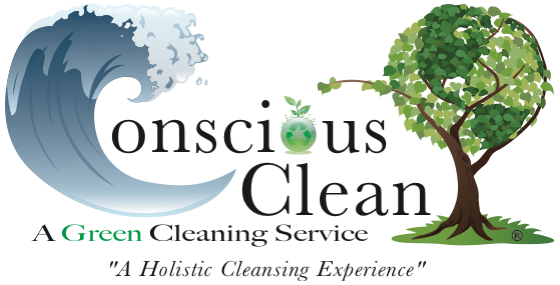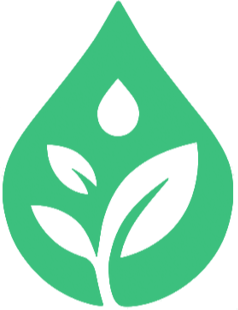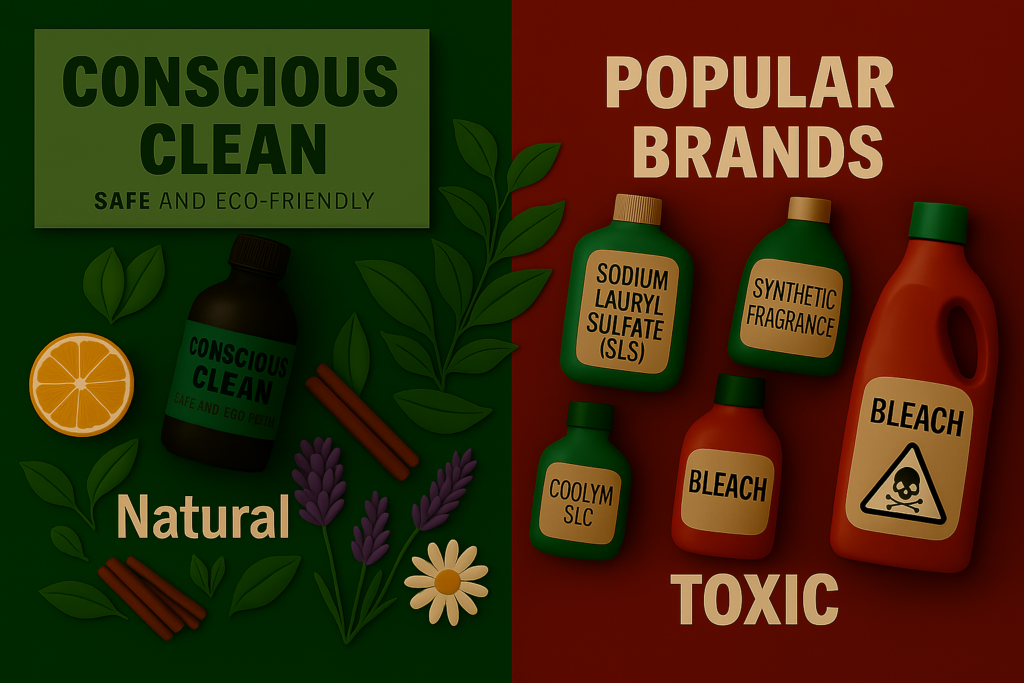
Conscious Clean vs. Conventional: Ingredient Face-Off
Conscious Clean believes in full transparency and using plant-powered, non-toxic ingredients that are tough on grime and gentle on you. Below is a product label comparison chart for the main product types, showing the typical conventional ingredients (and their dirty laundry) versus Conscious Clean’s thoughtfully chosen ingredients. We’ll also highlight where Conscious Clean’s components come from and why they’re safer.
| Product Type | Conventional Cleaners (Key Ingredients) | Conscious Clean (Key Ingredients) |
|---|---|---|
| All-Purpose Cleaner (Spray for countertops, glass, etc.) | Ammonia (ammonium hydroxide): Strong chemical cleaner that cuts grease but emits harsh fumes. Synthetic fragrance: Artificial scent blend (often contains phthalates) to mask chemical smell. | White vinegar (5% acetic acid): Fermented plant-based acid (from corn/grain) that dissolves grime and evaporates clean. Decyl glucoside: Mild surfactant derived from coconut and corn sugar – lifts dirt without irritation, 100% biodegradable. Lemon essential oil: Natural oil from lemon peel for fresh scent and antimicrobial boost (no phthalates, just real fruit essence). |
| Dish Soap (Liquid for hand-washing dishes) | Sodium lauryl sulfate (SLS): Cheap synthetic soap that produces lots of foam – and can dry out skin. Synthetic fragrance & dyes: Lab-made lemon or floral scent and coloring to make it look nice (adds zero cleaning value). | Coco-glucoside: Coconut-based cleanser (from coconut oil + fruit sugar) that cuts grease with gentle suds; non-toxic and skin-friendly. Vegetable glycerin: Plant-derived moisturizer (often from soy or coconut) that keeps hands from drying out, food-grade safe. Citrus essential oil: Natural orange and lemon oils for light scent and grease-cutting power – biodegradable and uplifting. |
| Hand Soap (Liquid foaming soap) | SLS/SLES (sulfates): Industrial detergents for lather that can strip natural oils from skin. Synthetic fragrance: “Fresh” scent made from chemicals, can contain allergens or endocrine disruptors (e.g., phthalates). (+ Antibacterial hand soaps often included triclosan, a now-banned antiseptic linked to hormone effects). | Saponified coconut & olive oil: Also known as castile soap, made by reacting natural oils with potash – creates a gentle, moisturizing soap that’s biodegradable (100% Plant-Based Cleaning Products Compared – My Chemical-Free House). Aloe vera gel: Plant extract known for soothing skin; adds moisture and natural preservation without harsh chemicals. Lavender essential oil: Pure lavender oil for a calming natural fragrance and mild antimicrobial properties – no synthetic junk, just distilled lavender flowers (100% Plant-Based Cleaning Products Compared – My Chemical-Free House). |
| Bathroom Cleaner (Tub & tile spray or toilet cleaner) | Chlorine bleach (sodium hypochlorite): Disinfects and whitens but with corrosive properties and toxic fumes. Synthetic fragrance: “Ocean fresh” scent attempting to cover the bleach smell; contributes to indoor air pollution. | Hydrogen peroxide (H₂O₂): A safe oxidizer (it’s literally water with an extra oxygen molecule) that kills germs and lifts stains, then breaks down into plain water and oxygen (Non-toxic disinfecting – David Suzuki Foundation). Citric acid: Organic acid from citrus fruits (like lemons); eats away soap scum and limescale naturally, found in food and inherently safe. Tea tree oil: Potent essential oil from the tea tree leaf – a natural antiseptic and mold-buster, adds a fresh herbal scent with no harmful residue. |
Table: Conventional vs. Conscious Clean ingredients across product categories. Notice a pattern? Conventional products rely on strong industrial chemicals (ammonia, bleach, sulfates, synthetic scents) that may clean but come with health trade-offs. Conscious Clean swaps those out for ingredients sourced from nature – plant oils, sugars, fruits, and minerals – that clean effectively without the chemical hangover. Each Conscious Clean ingredient has a story rooted in sustainability and safety:
-
Plant-Based Surfactants (Decyl Glucoside, Coco-Glucoside, Castile Soap): These are all derived from natural sources like coconut oil, corn sugar, or olive oil. Unlike SLS which is harsher, plant-based surfactants are known for being biodegradable and low in toxicity (Discover the Power of Plant-Based Surfactants – Clean and Green Solutions –). They break up grease and dirt but are non-irritating to skin and non-damaging to aquatic life. Castile soap, for example, has been used for centuries (ever heard of Grandma’s olive oil soap?) – it’s free of synthetics and the ultimate old-school green cleaner, yet it works wonders on grime.
-
Vinegar & Citric Acid: These kitchen staples are proof that you don’t need a degree in chemistry to have a powerful cleaner. White vinegar is simply acetic acid fermented from plants, and citric acid comes from citrus fruit fermentation. Both can dissolve mineral deposits, soap scum, and kill some germs, minus the toxic aftermath. They do have a tangy odor, but it’s one that won’t harm you – and it disappears quickly. Vinegar has been a household cleaning hero for ages (ever used it to clean a coffee maker or unclog a drain?). The reason is simple: it works, and when it’s done, it biodegrades into basically nothing. No chronic health effects, no environmental persistence – just a cleaner surface.
-
Hydrogen Peroxide: H₂O₂ is often called the chlorine bleach alternative, and for good reason. It’s a potent disinfectant and stain remover – when it encounters organic matter (like germs or stains), it oxidizes them (fancy word for busting them apart). The best part? After doing its job, it breaks down into water and oxygen (Non-toxic disinfecting – David Suzuki Foundation). No chloroform byproducts, no lingering fumes. It’s even used to sanitize drinking water and in wound care, so you know it’s not some sketchy new concoction. For cleaning toilets, tubs, or tiles, hydrogen peroxide gets things hygienic without requiring you to ventilate the room for dear life. It’s odorless, non-toxic, and environmentally benign – basically the poster child of conscious cleaning.
-
Essential Oils (Lemon, Lavender, Tea Tree, etc.): Rather than artificial fragrances, Conscious Clean uses essential oils distilled from real plants. These not only provide natural scent, but many have antimicrobial properties (tea tree and lavender, for instance, can inhibit bacteria and mold). Importantly, essential oils are literally plant extracts – derived via pressing or distillation from leaves, peels, flowers, etc. (100% Plant-Based Cleaning Products Compared – My Chemical-Free House). That means no mystery concoction, no phthalates needed to make them last. They do their job and smell lovely, then diffuse away without impacting your hormones. (Of course, essential oils are powerful in their pure form – but in Conscious Clean’s diluted formulas, they’re safe and gentle, only leaving behind a subtle, real fragrance.). It’s a transparent approach to scent: you know it comes from a lavender sprig or a lemon peel, not a laboratory’s secret recipe.
-
Natural Moisturizers & Stabilizers (Aloe Vera, Glycerin): Since harsh detergents are out, Conscious Clean adds plant-based goodies to keep your skin happy and products stable. Aloe vera gel comes from the aloe plant and is famed for its soothing, healing properties (hi, sunburn gel!). In cleaners, it can help condition your skin so your hands aren’t left dry after cleaning. Vegetable glycerin, similarly, is a byproduct of plant oils – it locks in moisture and also helps dissolve grime gently. These ingredients have stellar safety profiles (we eat glycerin in foods and use aloe in skincare regularly), so you get an extra layer of care in your cleaning routine.
In short, Conscious Clean’s ingredients come from farms and forests, not factories. They’re selected to be biocompatible (our bodies and ecosystems know how to deal with them) and effective without the need for hazard labels and poison control on speed dial. Peer-reviewed research and decades of use back up their safety: you won’t find them on lists of carcinogens or endocrine disruptors, and you won’t need gloves and a gas mask to use them. Cleaning with these feels good – no stinging eyes, no burning throat, no worrying about what you just breathed in or washed down the drain.
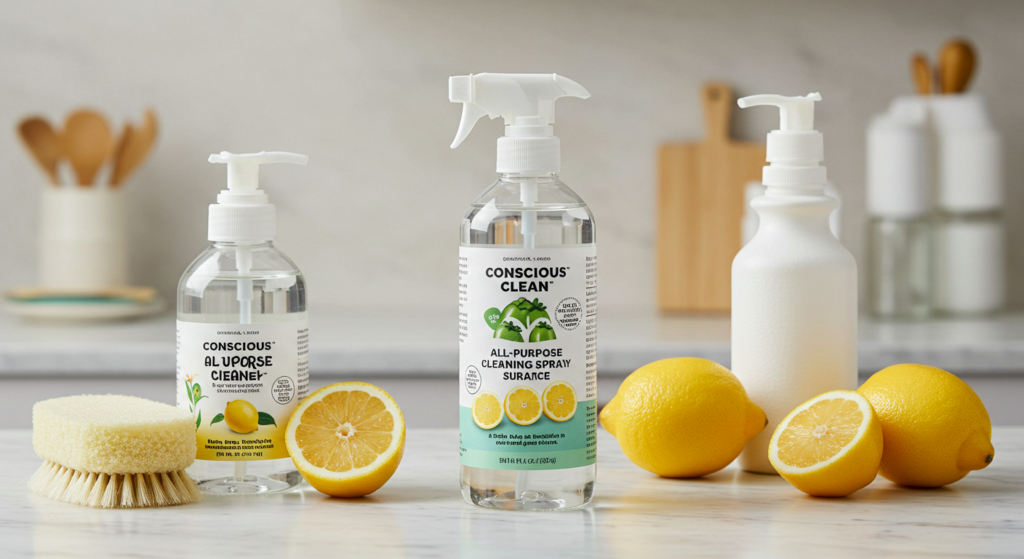
Cleaning with a Conscience: The Empowered Choice
Knowledge is power, and now you’re armed with the facts: you’ve seen that many conventional cleaning products get their oomph from chemicals that can do more harm than good. But you’ve also seen there’s a better way. Conscious Clean’s non-toxic alternatives prove that you don’t need to trade your health for a clean home. We’re transparent about every ingredient – if it’s on the label, you know what it is and where it comes from (and you can pronounce it!). The result? Products that are safe, effective, and kind to both you and the planet.
By swapping ammonia for vinegar, bleach for peroxide, SLS for coconut-based cleansers, and synthetic fragrances for essential oils, Conscious Clean empowers you to kick toxic chemicals to the curb. You can scrub your tub without inhaling noxious fumes, wash dishes without cracking your hands, and leave a fresh scent that doesn’t come with a side of hormone disruption. It’s cleaning that’s actually clean.
So next time you’re gearing up to battle household dirt, check the ingredient labels. You deserve to know what’s in your cleaners. If you see the usual suspects from our toxic hall of shame, you might hear our sassy voice in your head saying, “Girl, you don’t need that drama!” Instead, you can reach for a Conscious Clean product and clean confidently, knowing science (and common sense) have your back. Your home will sparkle, your air will be clear, and you’ll have zero need to worry about what’s left behind on your surfaces (or in our waterways).
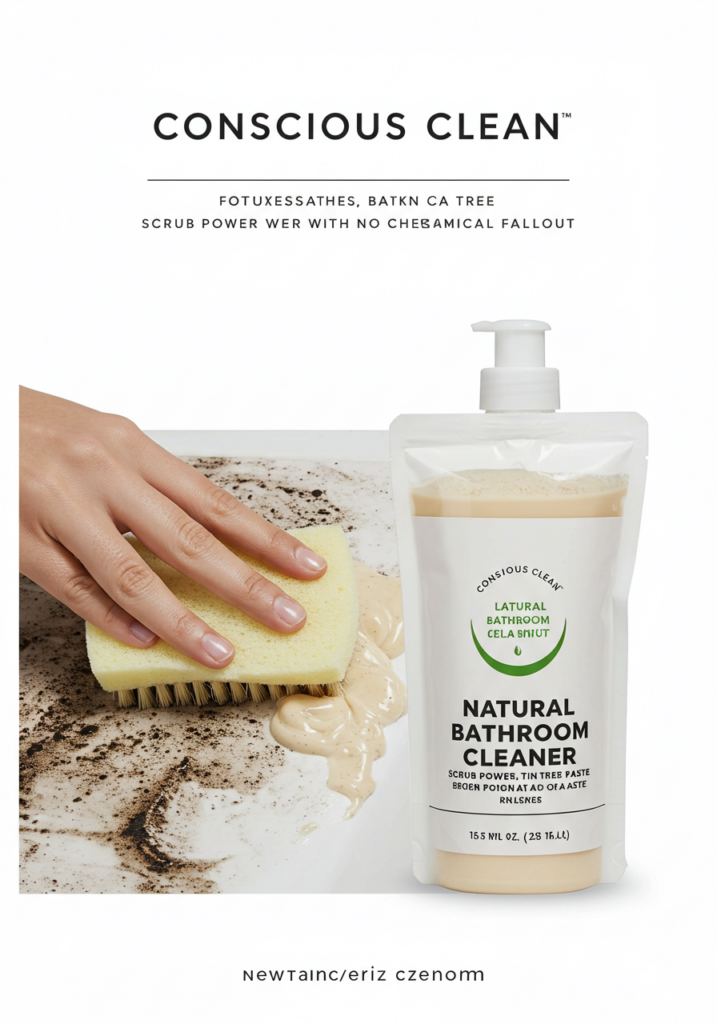
Empowering yourself with this knowledge is the first step to a healthier home. Remember: a truly clean home isn’t just about shiny counters – it’s about a safe environment for you and your family. With Conscious Clean’s transparent, non-toxic ingredients, you can clean effectively while staying true to your values. That’s cleaning with conscience and confidence – and your home, body, and planet will thank you for it!
SHARE
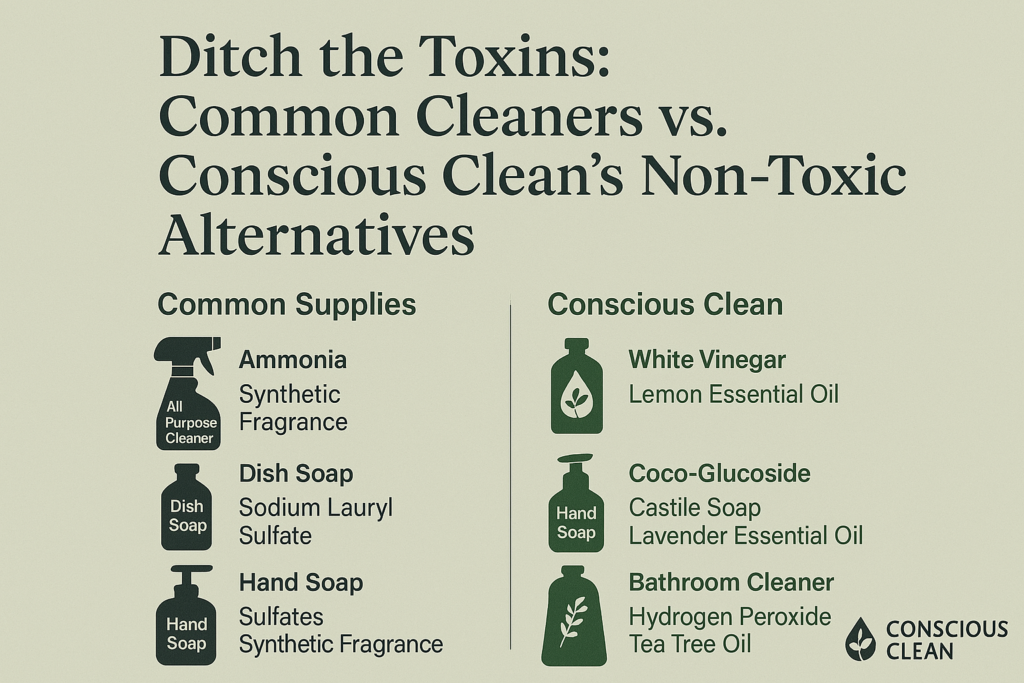
Ditch the Toxins: Common Cleaners vs. Conscious Clean’s Non-Toxic Alternatives
Everyday cleaning supplies promise a sparkling home, but many come with a dirty secret: harsh chemicals lurking behind the fresh scents and suds. It’s time to pull back the curtain on those conventional cleaners and see how Conscious Clean offers a sassy, safer alternative that kicks grime to the curb without kicking your health (or the planet) in the gut. In this report, we’ll break down:
-
The common harmful ingredients in all-purpose cleaners, dish soap, hand soap, and bathroom cleaners (and what they do).
-
The health and environmental risks tied to these ingredients (backed by science – receipts included!).
-
How Conscious Clean’s non-toxic ingredients stack up – with a side-by-side product label comparison chart.
-
The natural origins and gentle safety profile of Conscious Clean’s ingredients, proving you can clean effectively and consciously.
Let’s dive into the grime (and the science) to empower you with transparent info for a healthier, happier home!
Toxic Hall of Shame: Harmful Ingredients in Common Cleaners
Many mainstream cleaners are a cocktail of chemicals that get the job done but may do a number on your health and the environment. Here are the top offenders to watch out for:
Sodium Lauryl Sulfate (SLS)
What it does: SLS is the infamous suds-maker found in dish soaps, laundry detergents, all-purpose cleaners, and even shampoos. It’s a cheap, high-foaming surfactant that blasts away grease and grime, giving you that satisfying lather and “clean” feeling. Basically, it’s the workhorse detergent that helps liquids spread and penetrate dirt.
Why it’s harmful: The downside? SLS doesn’t know when to quit – it can strip oils too effectively. Research shows even low concentrations (around 1–2%) of SLS can dry out and irritate your skin with prolonged contact ( Human and Environmental Toxicity of Sodium Lauryl Sulfate (SLS): Evidence for Safe Use in Household Cleaning Products – PMC ). It’s such a known irritant that scientists often use it to intentionally induce skin inflammation in lab tests! ( Human and Environmental Toxicity of Sodium Lauryl Sulfate (SLS): Evidence for Safe Use in Household Cleaning Products – PMC ) If you have sensitive skin or eczema, SLS is like that abrasive friend who always oversteps boundaries – your skin can end up red, itchy, or flaky. Environmentally, when SLS heads down the drain, it can spell trouble for aquatic life. In its undiluted form, SLS is moderately toxic to fish and other marine creatures (LC₅₀ in fish is around 1–13 mg/L) ( Human and Environmental Toxicity of Sodium Lauryl Sulfate (SLS): Evidence for Safe Use in Household Cleaning Products – PMC ). While it does biodegrade over time, enough SLS hitting our rivers can put freshwater critters at risk. Harsh on you, harsh on Nemo – no thanks!
Synthetic Fragrances
What they do: “Spring Breeze”, “Lemon Burst”, “Ocean Fresh” – whatever the pleasant name, synthetic fragrances are behind that distinctive clean smell in your sprays, soaps, and detergents. These lab-made scent mixtures can contain dozens of chemicals (often undisclosed, just labeled as “fragrance” or “parfum”). They’re added to make your home smell like a field of flowers rather than, well, bleach and ammonia. Functionally, they mask chemical odors and leave a lingering scent to signal “clean.”
Why they’re harmful: That “fresh linen” aroma can be a wolf in sheep’s clothing. Synthetic fragrances are a top trigger for allergies and irritations – one study found about one in three people experience health problems (think headaches, sneezing, asthma attacks) when exposed to fragranced products (Fragranced consumer products: exposures and effects from emissions – PubMed). We’re talking migraines, wheezing, skin rashes, you name it. A big reason is what’s in those fragrances: many contain volatile organic compounds (VOCs) that can form indoor air pollutants, plus oftentimes phthalates (see below) that help the scent linger. Some common fragrance chemicals are even linked to hormone disruption. In short, that “mountain fresh” spray might actually be polluting your indoor air and stressing your body. Breathing synthetic fragrance is like inviting a chemical soup into your lungs – hard pass.
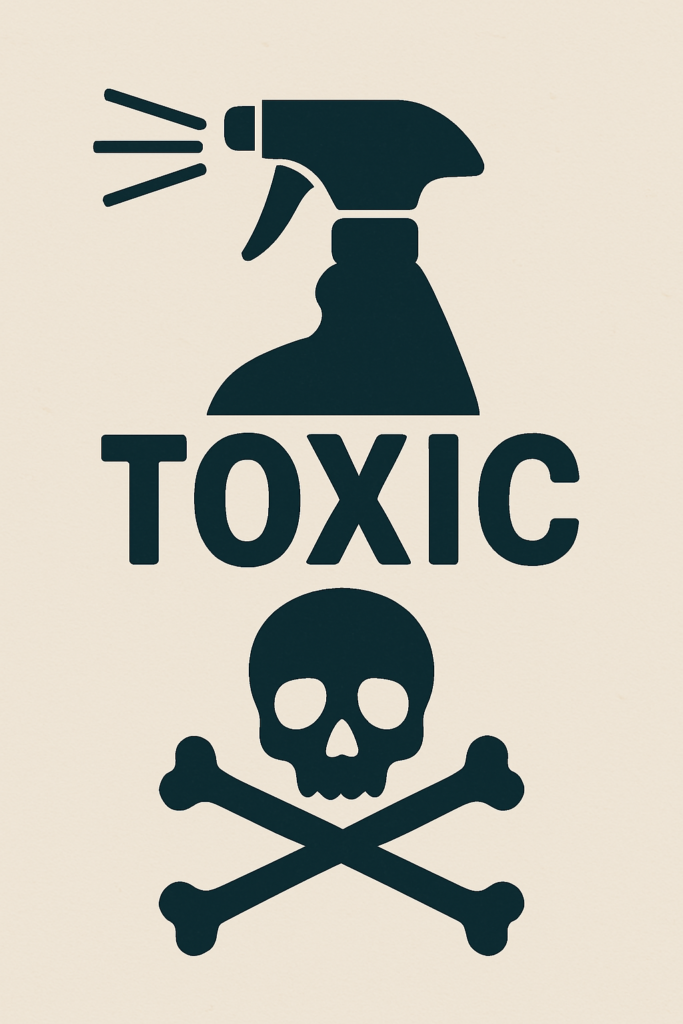
Bleach (Chlorine Bleach)
What it does: Bleach is the blunt instrument of cleaning products – usually a solution of sodium hypochlorite. It’s found in many bathroom cleaners, toilet bowl gels, and mildew removers. Bleach is in your arsenal to disinfect and whiten: it kills germs on contact, obliterates mold, and removes stains (hello, bright white bathtub). It’s the nuclear option for grime, and that’s why conventional products love it for “deep clean” formulations.
Why it’s harmful: Bleach might make your surfaces look hospital-clean, but it can make your home smell like one too – and that chlorine stench is a red flag. Bleach gives off harsh, chlorine gas fumes that can irritate your eyes, skin, and especially your respiratory tract (Cleaning Supplies and Household Chemicals | American Lung Association). Ever felt your throat burn or lungs ache after scrubbing with bleach? That’s the bleach saying “hello” (in the rudest way). Studies link regular use of bleach-containing cleaners to higher risks of asthma and chronic lung issues in cleaning workers () (Kids Prone to Asthma If Mothers Exposed to Cleaning Products at Work – Business Insider). One long-term study even compared the lung function decline in women who cleaned with chemical agents (like bleach) to smoking 20 cigarettes a day () – yikes! And whatever you do, never mix bleach with ammonia – together they create chloramine gas, a toxic fume that can cause serious breathing problems or even death (Cleaning Supplies and Household Chemicals | American Lung Association). Bleach can also form other nasty byproducts; for instance, research found bleach use can generate carcinogenic compounds like chloroform in the air (). So that “powerful clean” comes with some powerful risks – essentially trading dirt for damage.
Ammonia
What it does: Ammonia (often listed as ammonium hydroxide in cleaners) is the secret behind streak-free shine. It’s a strong alkaline cleaner used in glass cleaners, multi-surface sprays, and floor cleaners to cut through grease and evaporate fast without residue. If you’ve used a blue window cleaner that makes you cough, that’s the ammonia at work. It excels at dissolving oils and removing fingerprints from glass, tile, and stainless steel, leaving a gleaming, no-streak finish.
Why it’s harmful: Ammonia’s pungent odor is basically a warning label. Even at low levels, ammonia fumes can irritate your eyes, nose, and throat almost instantly (Ammonia | Chemical Emergencies | CDC). That sudden sniffly, burning sensation when cleaning an unventilated bathroom? Classic ammonia exposure. It can cause coughing, wheezing, and is especially nasty if you have asthma or sensitive lungs – studies suggest frequent exposure to ammonia may contribute to new-onset asthma symptoms (Kids Prone to Asthma If Mothers Exposed to Cleaning Products at Work – Business Insider). In concentrated form, it’s corrosive enough to burn skin or eyes (The Facts About Ammonia – New York State Department of Health). And remember the bleach cocktail from hell? Ammonia is one half of it – when combined with chlorine bleach, it creates a poisonous gas that can send you to the ER (Cleaning Supplies and Household Chemicals | American Lung Association). Environment-wise, ammonia pouring down the drain can lead to algal blooms and fish toxicity in high amounts, since it’s essentially adding excess nitrogen to waterways. Bottom line: for a supposed cleaning “aid,” ammonia can be more trouble than it’s worth – if a cleaner makes your eyes water and lungs ache, it’s probably not the healthiest choice.
Phthalates
What they do: Phthalates (pronounced thal-ates) are a group of chemicals commonly used as “plasticizers” and fragrance fixatives. In cleaning products, you’ll find phthalates lurking in synthetic fragrances – they help scents linger longer on surfaces and stabilize the fragrance formula. They’re not usually listed on labels (they hide behind the term “fragrance”), but if your dish soap or air freshener has a strong scent that lasts, you can bet phthalates are part of the magic. They’re also in some plastic packaging, but our focus is their role in scented cleaners and detergents.
Why they’re harmful: Phthalates are the divas of disruption – hormonal disruption, that is. These chemicals are well-documented endocrine disruptors that can mimic or interfere with your body’s hormones ( Phthalates and Their Impacts on Human Health – PMC ). Prolonged exposure has been linked to a laundry list of health issues: reproductive problems (like lower sperm count or fertility issues), developmental defects in children, and even impacts on IQ and neurodevelopment ( Phthalates and Their Impacts on Human Health – PMC ). One review bluntly concludes that phthalates are “detrimental to human health,” capable of affecting multiple organ systems ( Phthalates and Their Impacts on Human Health – PMC ). There’s also emerging evidence tying phthalates to things like insulin resistance, obesity, and cardiovascular issues (Perfume chemicals tied to hormone disruption and health risks – EHN). In fact, scientists recently raised alarms that phthalate exposure is associated with higher rates of insulin resistance and neurodevelopmental problems in children (Perfume chemicals tied to hormone disruption and health risks – EHN). These chemicals mess with our hormones in ways that can echo for years – even across generations. So that scented multi-surface cleaner might leave your home smelling like a meadow, but it could be leaving behind invisible phthalate residue that your family then inhales or absorbs. Considering some countries have banned certain phthalates in toys and baby products, it’s pretty concerning to find them sloshing around in your mop bucket. No one asked for a side of hormone havoc with their clean house!
Now that we’ve met the toxic antagonists in your cleaning closet, you might be feeling a mix of anger (why are these even allowed in our homes?!) and empowerment (knowledge is power, after all). Take a deep breath – the good news is, you don’t have to tolerate these nasties to get a clean, healthy home. Conscious Clean was created to be the hero of this story, offering products that deliver a sparkling clean without the spooky side effects. Let’s flip the script and see how Conscious Clean’s ingredients compare.

Conscious Clean vs. Conventional: Ingredient Face-Off
Conscious Clean believes in full transparency and using plant-powered, non-toxic ingredients that are tough on grime and gentle on you. Below is a product label comparison chart for the main product types, showing the typical conventional ingredients (and their dirty laundry) versus Conscious Clean’s thoughtfully chosen ingredients. We’ll also highlight where Conscious Clean’s components come from and why they’re safer.
| Product Type | Conventional Cleaners (Key Ingredients) | Conscious Clean (Key Ingredients) |
|---|---|---|
| All-Purpose Cleaner (Spray for countertops, glass, etc.) | Ammonia (ammonium hydroxide): Strong chemical cleaner that cuts grease but emits harsh fumes. Synthetic fragrance: Artificial scent blend (often contains phthalates) to mask chemical smell. | White vinegar (5% acetic acid): Fermented plant-based acid (from corn/grain) that dissolves grime and evaporates clean. Decyl glucoside: Mild surfactant derived from coconut and corn sugar – lifts dirt without irritation, 100% biodegradable. Lemon essential oil: Natural oil from lemon peel for fresh scent and antimicrobial boost (no phthalates, just real fruit essence). |
| Dish Soap (Liquid for hand-washing dishes) | Sodium lauryl sulfate (SLS): Cheap synthetic soap that produces lots of foam – and can dry out skin. Synthetic fragrance & dyes: Lab-made lemon or floral scent and coloring to make it look nice (adds zero cleaning value). | Coco-glucoside: Coconut-based cleanser (from coconut oil + fruit sugar) that cuts grease with gentle suds; non-toxic and skin-friendly. Vegetable glycerin: Plant-derived moisturizer (often from soy or coconut) that keeps hands from drying out, food-grade safe. Citrus essential oil: Natural orange and lemon oils for light scent and grease-cutting power – biodegradable and uplifting. |
| Hand Soap (Liquid foaming soap) | SLS/SLES (sulfates): Industrial detergents for lather that can strip natural oils from skin. Synthetic fragrance: “Fresh” scent made from chemicals, can contain allergens or endocrine disruptors (e.g., phthalates). (+ Antibacterial hand soaps often included triclosan, a now-banned antiseptic linked to hormone effects). | Saponified coconut & olive oil: Also known as castile soap, made by reacting natural oils with potash – creates a gentle, moisturizing soap that’s biodegradable (100% Plant-Based Cleaning Products Compared – My Chemical-Free House). Aloe vera gel: Plant extract known for soothing skin; adds moisture and natural preservation without harsh chemicals. Lavender essential oil: Pure lavender oil for a calming natural fragrance and mild antimicrobial properties – no synthetic junk, just distilled lavender flowers (100% Plant-Based Cleaning Products Compared – My Chemical-Free House). |
| Bathroom Cleaner (Tub & tile spray or toilet cleaner) | Chlorine bleach (sodium hypochlorite): Disinfects and whitens but with corrosive properties and toxic fumes. Synthetic fragrance: “Ocean fresh” scent attempting to cover the bleach smell; contributes to indoor air pollution. | Hydrogen peroxide (H₂O₂): A safe oxidizer (it’s literally water with an extra oxygen molecule) that kills germs and lifts stains, then breaks down into plain water and oxygen (Non-toxic disinfecting – David Suzuki Foundation). Citric acid: Organic acid from citrus fruits (like lemons); eats away soap scum and limescale naturally, found in food and inherently safe. Tea tree oil: Potent essential oil from the tea tree leaf – a natural antiseptic and mold-buster, adds a fresh herbal scent with no harmful residue. |
Table: Conventional vs. Conscious Clean ingredients across product categories. Notice a pattern? Conventional products rely on strong industrial chemicals (ammonia, bleach, sulfates, synthetic scents) that may clean but come with health trade-offs. Conscious Clean swaps those out for ingredients sourced from nature – plant oils, sugars, fruits, and minerals – that clean effectively without the chemical hangover. Each Conscious Clean ingredient has a story rooted in sustainability and safety:
-
Plant-Based Surfactants (Decyl Glucoside, Coco-Glucoside, Castile Soap): These are all derived from natural sources like coconut oil, corn sugar, or olive oil. Unlike SLS which is harsher, plant-based surfactants are known for being biodegradable and low in toxicity (Discover the Power of Plant-Based Surfactants – Clean and Green Solutions –). They break up grease and dirt but are non-irritating to skin and non-damaging to aquatic life. Castile soap, for example, has been used for centuries (ever heard of Grandma’s olive oil soap?) – it’s free of synthetics and the ultimate old-school green cleaner, yet it works wonders on grime.
-
Vinegar & Citric Acid: These kitchen staples are proof that you don’t need a degree in chemistry to have a powerful cleaner. White vinegar is simply acetic acid fermented from plants, and citric acid comes from citrus fruit fermentation. Both can dissolve mineral deposits, soap scum, and kill some germs, minus the toxic aftermath. They do have a tangy odor, but it’s one that won’t harm you – and it disappears quickly. Vinegar has been a household cleaning hero for ages (ever used it to clean a coffee maker or unclog a drain?). The reason is simple: it works, and when it’s done, it biodegrades into basically nothing. No chronic health effects, no environmental persistence – just a cleaner surface.
-
Hydrogen Peroxide: H₂O₂ is often called the chlorine bleach alternative, and for good reason. It’s a potent disinfectant and stain remover – when it encounters organic matter (like germs or stains), it oxidizes them (fancy word for busting them apart). The best part? After doing its job, it breaks down into water and oxygen (Non-toxic disinfecting – David Suzuki Foundation). No chloroform byproducts, no lingering fumes. It’s even used to sanitize drinking water and in wound care, so you know it’s not some sketchy new concoction. For cleaning toilets, tubs, or tiles, hydrogen peroxide gets things hygienic without requiring you to ventilate the room for dear life. It’s odorless, non-toxic, and environmentally benign – basically the poster child of conscious cleaning.
-
Essential Oils (Lemon, Lavender, Tea Tree, etc.): Rather than artificial fragrances, Conscious Clean uses essential oils distilled from real plants. These not only provide natural scent, but many have antimicrobial properties (tea tree and lavender, for instance, can inhibit bacteria and mold). Importantly, essential oils are literally plant extracts – derived via pressing or distillation from leaves, peels, flowers, etc. (100% Plant-Based Cleaning Products Compared – My Chemical-Free House). That means no mystery concoction, no phthalates needed to make them last. They do their job and smell lovely, then diffuse away without impacting your hormones. (Of course, essential oils are powerful in their pure form – but in Conscious Clean’s diluted formulas, they’re safe and gentle, only leaving behind a subtle, real fragrance.). It’s a transparent approach to scent: you know it comes from a lavender sprig or a lemon peel, not a laboratory’s secret recipe.
-
Natural Moisturizers & Stabilizers (Aloe Vera, Glycerin): Since harsh detergents are out, Conscious Clean adds plant-based goodies to keep your skin happy and products stable. Aloe vera gel comes from the aloe plant and is famed for its soothing, healing properties (hi, sunburn gel!). In cleaners, it can help condition your skin so your hands aren’t left dry after cleaning. Vegetable glycerin, similarly, is a byproduct of plant oils – it locks in moisture and also helps dissolve grime gently. These ingredients have stellar safety profiles (we eat glycerin in foods and use aloe in skincare regularly), so you get an extra layer of care in your cleaning routine.
In short, Conscious Clean’s ingredients come from farms and forests, not factories. They’re selected to be biocompatible (our bodies and ecosystems know how to deal with them) and effective without the need for hazard labels and poison control on speed dial. Peer-reviewed research and decades of use back up their safety: you won’t find them on lists of carcinogens or endocrine disruptors, and you won’t need gloves and a gas mask to use them. Cleaning with these feels good – no stinging eyes, no burning throat, no worrying about what you just breathed in or washed down the drain.

Cleaning with a Conscience: The Empowered Choice
Knowledge is power, and now you’re armed with the facts: you’ve seen that many conventional cleaning products get their oomph from chemicals that can do more harm than good. But you’ve also seen there’s a better way. Conscious Clean’s non-toxic alternatives prove that you don’t need to trade your health for a clean home. We’re transparent about every ingredient – if it’s on the label, you know what it is and where it comes from (and you can pronounce it!). The result? Products that are safe, effective, and kind to both you and the planet.
By swapping ammonia for vinegar, bleach for peroxide, SLS for coconut-based cleansers, and synthetic fragrances for essential oils, Conscious Clean empowers you to kick toxic chemicals to the curb. You can scrub your tub without inhaling noxious fumes, wash dishes without cracking your hands, and leave a fresh scent that doesn’t come with a side of hormone disruption. It’s cleaning that’s actually clean.
So next time you’re gearing up to battle household dirt, check the ingredient labels. You deserve to know what’s in your cleaners. If you see the usual suspects from our toxic hall of shame, you might hear our sassy voice in your head saying, “Girl, you don’t need that drama!” Instead, you can reach for a Conscious Clean product and clean confidently, knowing science (and common sense) have your back. Your home will sparkle, your air will be clear, and you’ll have zero need to worry about what’s left behind on your surfaces (or in our waterways).

Empowering yourself with this knowledge is the first step to a healthier home. Remember: a truly clean home isn’t just about shiny counters – it’s about a safe environment for you and your family. With Conscious Clean’s transparent, non-toxic ingredients, you can clean effectively while staying true to your values. That’s cleaning with conscience and confidence – and your home, body, and planet will thank you for it!
